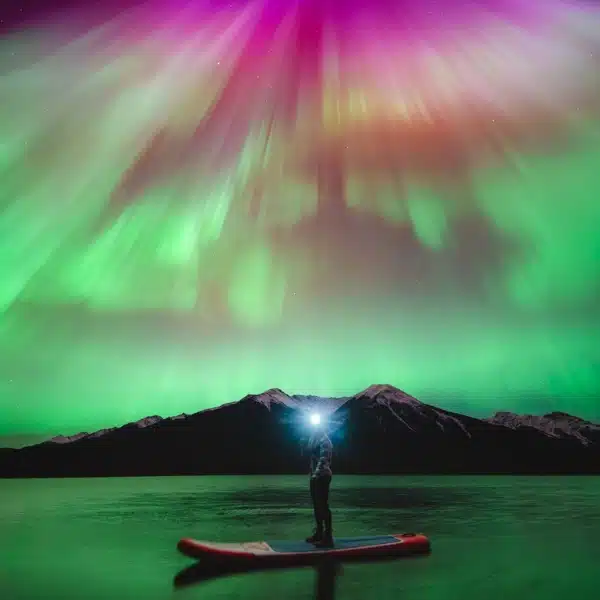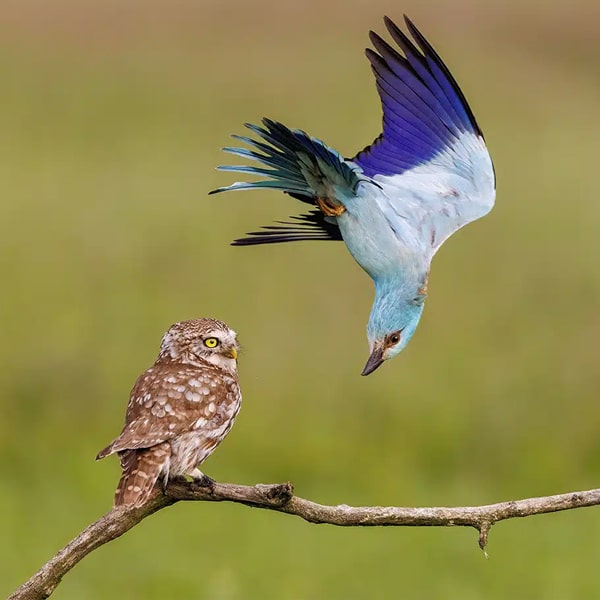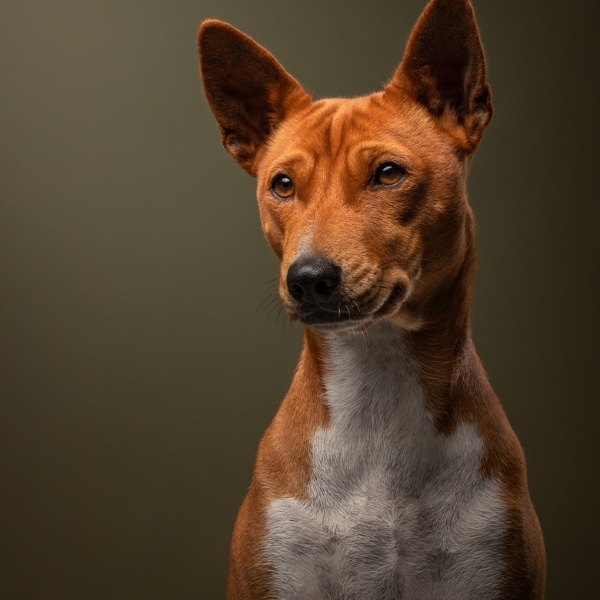
“Frozen Mobil Home” by Greg Lecoeur (France). Underwater Photographer of the Year 2020.
“Massive and mysterious habitats, icebergs are dynamic kingdoms that support marine life. As they swing and rotate slowly through polar currents, icebergs fertilize the oceans by carrying nutrients from land that spark blooms of phytoplankton, fundamental to the carbon cycle. During an expedition in Antarctica Peninsula with filmmaker Florian Fisher and freediver Guillaume Nery, we explored and documented the hidden face of this iceberg where crab-eater seals have taken up residence on icebergs that drift at the whim of polar currents.” (© Greg Lecoeur/UPY2020)
Renowned photographer Greg Lecoeur beat out a skilled crowd to win the 2020 Underwater Photographer of the Year contest. His spectacular photo of crab-eater seals frolicking among icebergs in Antarctica triumphed over 5,500 other images from photographers in 70 countries. It's an important win as the UK-based competition has been a leader in promoting global underwater photography since 1965, making it one of the premier prizes in the field.
The expert panel of judges was enamored with Lecoeur's photo, making it the clear winner. “The balletic rhythm of these crabeater seals and the ethereal landscape of the pitted iceberg creates a composition that draws you into a corner of the world that few people have witnessed,” shared judge Alex Mustard, a marine biologist and acclaimed underwater photographer. “The multiple subjects take my eyes on a journey through the frame and into the icy ocean of Antarctica.”
Several other photographers earned special accolades, including Pasquale Vassallo. The Italian photographer not only won the Behavior category for his photo of an octopus balancing a soccer ball on its head, but was also named Marine Conservation Photographer of the Year 2020. His photograph of a tuna being scooped up by a fishing boat expertly demonstrates the harsh end of life for many marine animals.
“If a picture paints a thousand words, then a great one asks a thousand questions,” stated judge Peter Rowland. “All we can do is show the truth to those who live above but can’t envisage the world below and hope that they start asking questions.”
Also singled out was Bahamian photographer Anita Kainrath. Her striking photograph of lemon shark pups swimming among mangroves earned her the title of Up & Coming Underwater Photographer 2020. Kainrath's patience in gaining these predators' trust was rewarded with a balanced composition that speaks volumes of her talent.
All the winning photographers get to select from an incredible prize pool, which includes diving trips and specialized underwater photography equipment.
See more winning images from the 2020 Underwater Photographer of the Year contest.

“Lemon shark nursery” by Anita Kainrath (Bahamas). Up & Coming Underwater Photographer of the Year 2020.
“The Bahamas has been a shark sanctuary since 2011 but Mangroves aren’t protected yet and that’s where these lemon shark pups spend the first 5-8 years of their lives.
I was standing in knee-high water, trying to hold my camera still, waiting for the sharks. Trying not to move when you have mosquitoes and sand-flies buzzing around you was probably the part I struggled with the most at this moment.
After less than one hour the little predators came closer and finally swam around my feet and my camera, bumping against me and trying to taste my strobes. They are curious little fellas but you need time to gain their trust and I love observing them in their natural habitat and that’s what I wanted to capture. They are such characters and we need to protect their nurseries in order to make sure their population is not declining.” (© Anita Kainrath/UPY2020)

“Last Dawn, Last Gasp” by Pasquale Vassallo (Italy). Marine Conservation Photographer of the Year 2020.
“This winter, I went diving with some local fishermen. At 6 in the morning I was already in the water, as the nets were raised at first light. During the dive I followed the path of the fishing nets from the bottom to the surface. As the fishermen quickly hauled on the nets, I tried to take some shots of trapped fish still suffering in the mesh, such as this tuna (Euthynnus alletteratus).” (© Pasquale Vassallo/UPY2020)

“Rabbit Fish Zoom Blur” by Nicholas More (United Kingdom). British Underwater Photographer of the Year 2020.
“I have been taking motion blur pictures for a few years now. I like how the technique adds dynamism to pictures. The picture was taken in Raja Ampat, Indonesia in November 2019 and I spent the morning taking fish portrait images. I came across a school of very friendly Rabbit fish under a jetty and took lots of schooling shots. I started using the extensive zoom range of my Sigma 17-70 combined with a slow shutter speed to create zoom blur images. The picture came together when the school bunched tightly together in a vertical tower with them all facing onto the camera. I hit the shutter and zoomed in at the same time, the flash freezing the central fish with the ambient light creating a Pop-Art like effect.” (© Nicholas More/UPY2020)

“Constellation of Eagle Rays” by Henley Spiers (United Kingdom). Runner Up, Black & White.
“A school of uniquely patterned spotted eagle rays passes beneath me on an unforgettable dive in the Maldives. Like most divers, I have always found these rays to be especially spellbinding, but also highly elusive! This school passed beneath me towards the end of our dive and it was one of those rare moments of huge admiration, as well as immense inspiration. I could visualize the image I wanted and, whilst the rays glided effortlessly, I swam my heart out trying to keep up and unlock the desired camera angle. The rays continued forward and deeper, giving me just a few moments to capture this frame. Scientists have just recently confirmed that the spotting on each ray is a unique identifier, the equivalent of a human fingerprint. I love how black and white reinforces that uniqueness, keenly displaying the distinctive spotting, as well as the subtle shading differences between each individual.” (© Henley Spiers/UPY2020)

“The Engine” by Tobias Friedrich (Germany). Winner, Wrecks.
“Panoramic image of the engine room of the Chrisoula K. with six video lights placed behind the engines. I went there on several trips with a live-aboard, being able to check out the possibilities of creating some different lighting in the wrecks. But usually the boats do only 1-2 dives per wreck, so I had to be quick in decisions. The space between the engine inside the wreck is very narrow and the angle for a single photo was just not enough, so I thought it was the best idea to create a panoramic image to display the machine room in one shot. Placing the lights took some time as well to find the right mix of ambiance and light from the outside. Because the wreck is dived a lot in the Red Sea I had to wait for a good slot when nobody was inside it.” (© Tobias Friedrich/UPY2020)

“Like Water for Silk” by Laura Storm (United Kingdom). Winner, British Waters Macro.
“Over the past couple of years, I’ve been photographing British freshwater habitats underwater. One of the stories that has captivated me is that of the Common frog. During its lifetime it has an estimated 0.25% chance of survival. It morphs like no other creature and along the way, experiences the most fantastic journey.
This tiny Common froglet is less than 1cm in length. It is so weightless it can balance on single, silken stands of Spirogyra. These algae filaments, an abundant and vital first link in freshwater food webs, reproduce rapidly leading to thousands of individual strands. They are a simple life form which combine into a tangled labyrinth known as water silk.
To highlight the water silk habitat, I used two off-camera lights strategically placed. One to help light the tiny froglet and the other to allow the tangle of algae strands to shine through.” (© Laura Storm/UPY2020)

“Fotteyo overhangs” by Oleg Gaponyuk (Russian Federation). Runner Up, Wide Angle.
“Fotteyo overhangs, with golden bunches of soft corals that you can see in this picture, is a rather famous place in the southern Maldives. It is impossible to cover the cave even with a fisheye lens due to its small depth. That’s how I decided to create a panorama of this place. It was my first underwater panorama created with the use of lighting and I am so happy that such technologies push the boundaries of underwater photography. The Maldives are experiencing difficult times as the temperature rise has led to the death of many hard corals. Nevertheless, there are places that have preserved the pristine beauty, and I am happy to share it with my spectators.” (© Oleg Gaponyuk/UPY2020)

“Octopus Training” by Pasquale Vassallo (Italy). Winner, Behavior.
“At the end of a session of freediving, I noticed a soccer ball, in the distance and on the surface. Intrigued I approached it, and then I noticed that below it was an octopus that was being pulled along by the current. I do not know what it was doing under the ball, but I think it is training for the next football World Cup! There was time for me to take a couple of shots before the octopus let go of the ball and dropped back to the seabed.” (© Pasquale Vassallo/UPY2020)

“Commotion in the Ocean” by Nur Tucker (United Kingdom). Most Promising British Underwater Photographer 2020.
“This image shows my very favorite of the species, the thorny sea horse. Over time, I have tried many different techniques, with varying degrees of success, including backlighting, side lighting, snooting, panning, double exposure, and silhouette shots. I love experimenting even if this comes at the expense of a wasted dive. On this particular dive, in Dumaguete (Philippines), I was keen to aim for something different and potentially offbeat. I began with a panning shot of the sea horse, captured with a 1/4 second shutter speed and a small, f/25 aperture. Then, I used the same settings to capture a panning shot of a shiny scouring pad, carried in my pocket. Both images were merged, in-camera, for the resulting double exposure shot. I must have repeated this sequence 50 times before eventually achieving this one when he made eye contact, which pleased me.” (© Nur Tucker/UPY2020)

“Goby Goodness” by Hannes Klostermann (Gemany). Winner, Macro.
“During the dive that I took this image on I swam a grand total of about 30 meters. I dropped down from the surface and descended towards the shallow, pristine coral reef in the Cayman Islands when I spotted this little fella posing right at the top of a coral head. I noticed the purple sea fan in the background and suspected it would look pleasing with a shallow depth of field, a look I really like in macro photography. After I had taken the first image and reviewed it I knew I would spend the entire dive with this goby, as the complementary colors of the fan and coral head worked very well together. Thankfully, the goby really seemed to enjoy the prime spot at the top of the coral head so it kept coming back to have its picture taken, not minding my close approach one bit.” (© Hannes Klostermann/UPY2020)
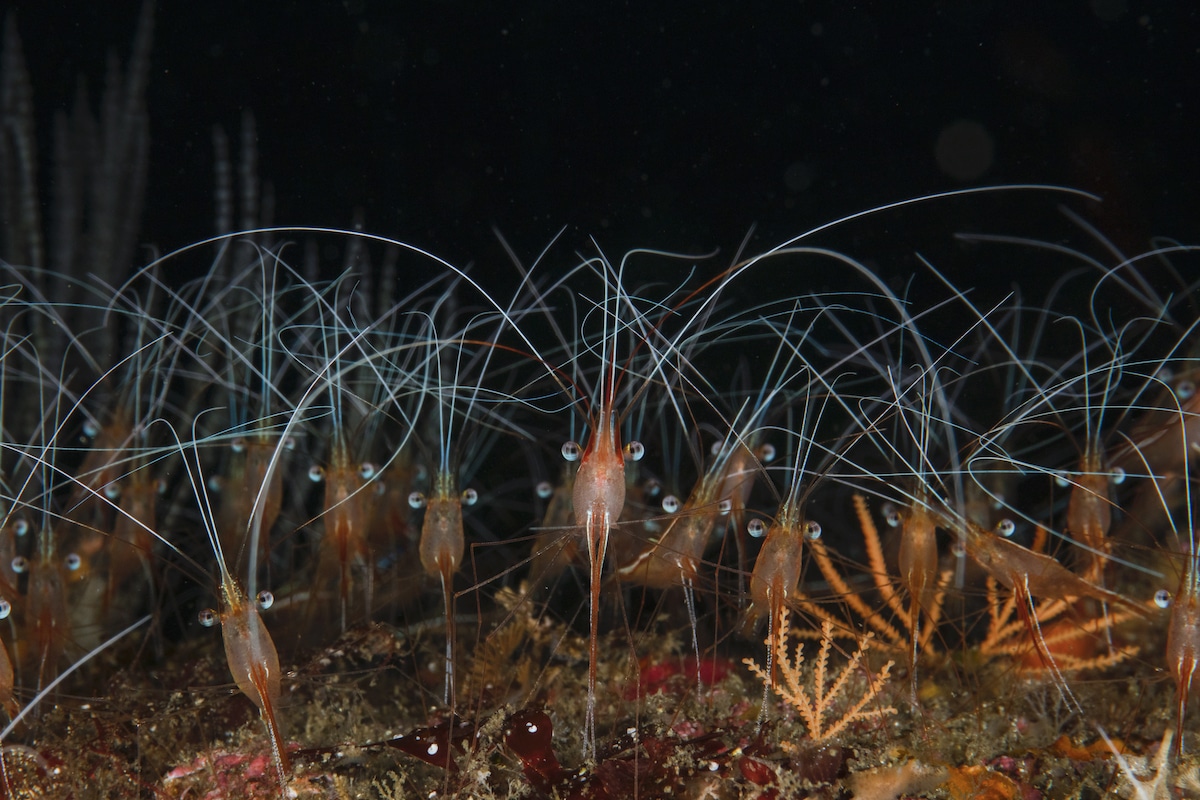
“Eyes” by Keigo Kawamura (Japan). Runner Up, Macro.
“The Unicorn shrimp usually inhabits around 200 to 300 meters deep, but they rise to about 40 meters due to breeding behavior. There are thousands to tens of thousands of shrimps but there are only a few suitable places to shoot them. The direction and density of the tide may vary depending on the direction, strength, and brightness in the ocean. I went there many times because I could only stay for 15 minutes once a day. I was lucky to be able to find and shoot the ideal situation.” (© Keigo Kawamura/UPY2020)

“Layered Thoughts” by Mok Wai Hoe (Singapore). Winner, Black & White.
“The creation of this image was inspired by in-camera double exposure photography.
This abstract style typically involves re-exposing the silhouette of a person against a textured background such as urban landscape. I was mesmerized by the aesthetics as well as the extensive possibilities of interpreting this form of visual art. At the same time, I also found no examples of the style applied underwater. Fueled with inspiration, I spent a year researching and experimenting to marry this technique with underwater photography. This black and white image was made by first shooting a silhouette against a cloudy afternoon sky. The picture was then re-exposed against the image of a coral garden. While this image pays homage to subjects most dear to me, I hope that viewers could find their own meaning as they juxtapose the elements and contrasting textures in the picture.” (© Mok Wai Hoe/UPY2020)

“Fireworks anemone sunburst” by Trevor Rees (United Kingdom). Third place, British Waters Wide Angle.
“This fireworks anemone (Pachycerianthus multiplicatus) was photographed at the head of Loch Dutch in Scotland at a depth of 15 meters. The water was dark and peat stained. It is a favorite subject that I have photographed many times before but this time I aimed for a different look and feel to the subject. I used the 28mm wide end of my zoom lens and positioned the anemone to the bottom right-hand side of the frame. To complete the image I added a sunburst taken by shooting towards the surface on the same dive, this time using the 70 mm end of the same zoom lens. It is a double exposure using an in-camera image overlay. It is a somewhat surreal view of this subject as these anemones normally live quite a bit deeper and capturing a sunburst in the same frame is almost impossible. That’s creativity eh?”(© Trevor Rees/UPY2020)
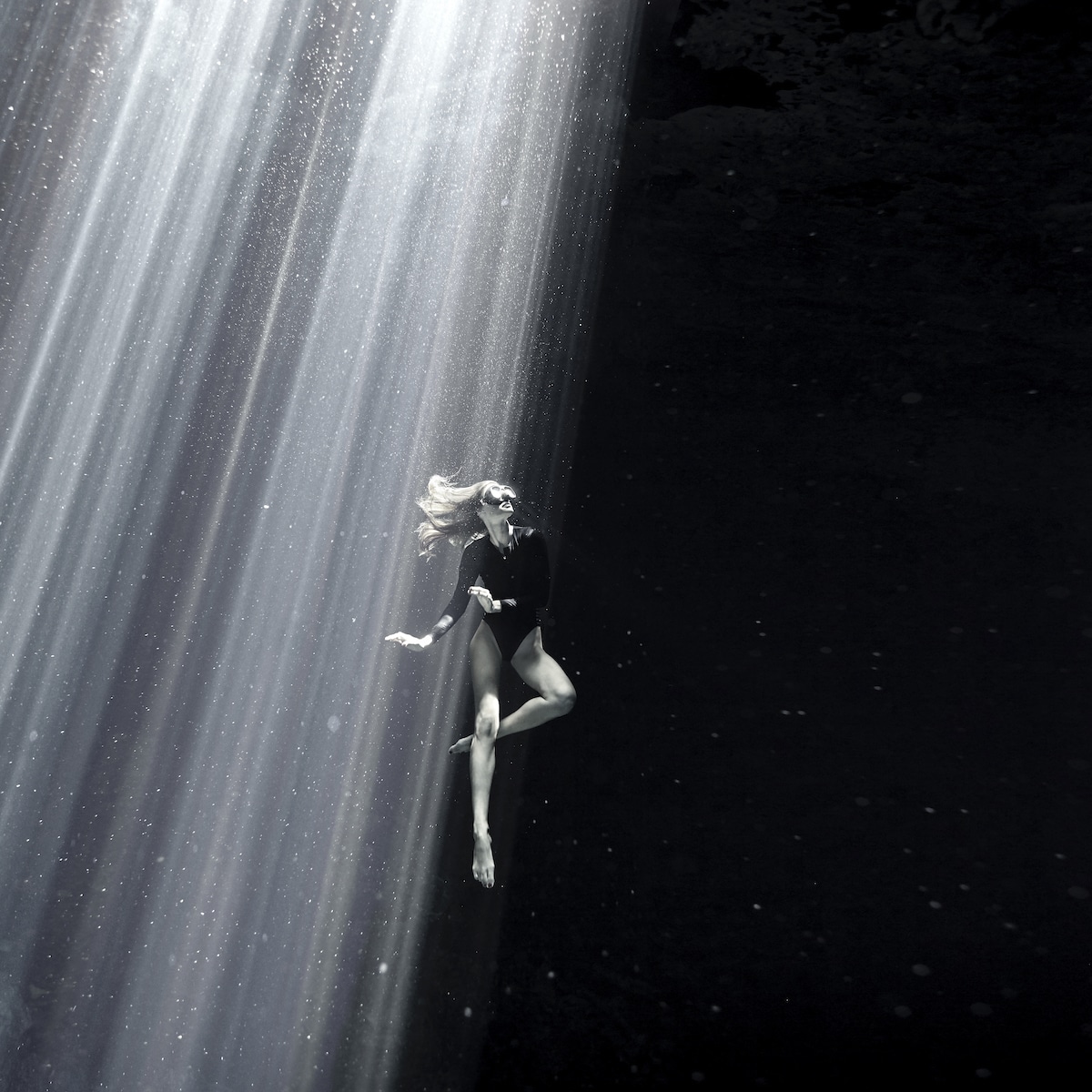
“Earthless” by Zena Holloway (United Kingdom). Third place, Black & White.
“This image takes place in the Ring of Cecomments in the Yucatan Peninsula of Mexico where the ancient Mayans believed the underground rivers were a gateway to another world. The Ring of Cecomments were created sixty-six million years ago when a colossal asteroid struck Earth. The impact was so powerful that it left behind a crater 180 kilometers across, and brought about climate change that led to the extinction of the dinosaurs. Throughout this region rivers now flow, deep underground through limestone rock that has, in places, collapsed to leave these remarkable caverns. In 2019 I was in Mexico, working on a photographic project about escaping gravity, inspired in part by the 50th anniversary of the moon landings. Whilst searching for ‘another world' I followed Brazilian free-diver and renowned conservationist, Flavia Eberhard, through a dark underwater passage and we emerged into this vast, unexplored space.” (© Zena Holloway/UPY2020)

“Saudi Titanic” by Renee Capozzola (United States). Runner Up, Wrecks.
“This split shot of the Georgios shipwreck was taken in Saudi Arabia in the area of NEOM, along the Gulf of Aqaba in the Red Sea. In 1978, this large cargo ship became stranded on a bed of corals and then had a large fire. The wreck is now known by many locals as the “Saudi Titanic” and sits halfway out of the water at the bow and in roughly 80 feet of water at the stern. There is a large school of tiny fish that live inside and there is abundant coral growth on the ship itself, which
now serves as an artificial reef for many marine organisms. I wanted to capture this wreck as a split to highlight more of the ship but at the time the light hit the port side, it was a bit wavy so I was fortunate to have gotten this shot!” (© Renee Capozzola/UPY2020)

“Uluna Lily” by Man BD (Malaysia). Winner, Compact.
“Uluna Lake in North Sulawesi located 670 meters above sea level is a place I’ve always wanted to visit. When I got the opportunity to dive in this freshwater lake at the end of last year, I knew what I wanted to shoot. As I stayed at YOS Dive Lembeh Eco Resort, the journey to the lake took less than two hours. This crystal clear springs lake is famous for its water lilies which only bloom in the morning and blue sky gave a good contrast when shooting. Geared with a mini-dome, I did my level best to shoot a split shot and staying very still to find the right angle and moment.” (© Man BD/UPY2020)














































































